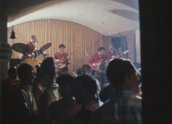
King of the Surf (1964)
Synopsis
In Sydney in 1964, the surfing fraternity welcomes the arrival of many of the world’s best surfers. They include young men from the USA, Hawaii, Great Britain, Peru, France, New Zealand and South Africa. After an official welcome at Sydney Town Hall, competition begins in earnest at Manly Beach, with the Australian surfer Midget Farrelly seeking the return of the unofficial world title he won in Hawaii in early 1963. He confirms that win with a confident display in the finals, defeating Hawaii’s Joey Cabell and Mike Doyle from the USA.
Curator’s notes
The 1964 contest was much more than a surfing competition. It was a grudge match, even if carried out in a sporting manner. Hawaiian surfers believed it was their sport, Californian surfers felt they were the best in the world, but Australia had Midget Farrelly, who had been victorious in early 1963 in Hawaii in the unofficial world championship, the invitation-only Makaha contest. The 1964 Manly championships were going to sort out the pecking order and the bragging rights. For Bob Evans, the Australian surfing entrepreneur who organised the contest, the championships were a crowning achievement of his eight years’ work since 1956.
He was publisher of the Australian magazine Surfing World and the leading Australian surf filmmaker. He had a column in a newspaper, did surf reports on radio and he organised dances at surf clubs, to encourage the surf music craze that began in 1962. For the 1964 championships, he organised sponsorship from the Australian oil company Ampol, which helped to bring the international stars to Sydney. The oil company also sponsored this film, which was the official record, made by Cinesound.
In his book, Surfmovies: The History of the Surf Film in Australia (2000, Shore Thing Publishing, ISBN 0 9587420 3 0) Albie Thoms describes this film as ‘the most comprehensive coverage of a surfing competition to date’. It was notable for its colour photography and the use of long telephoto lenses that were not usually affordable by surf-movie producers. The newsreel photographers were better trained and had better equipment than anyone making surf movies. Evans is credited on the film as scriptwriter. It is likely that he encouraged Ampol to sponsor the film, as well as the contest.
After Midget Farrelly won the Makaha title in early 1963, he went back to Hawaii at the end of that year and lost it, in the final against Hawaiian star Joey Cabell. The Manly contest took place six months later in May 1964, so there was much anticipation. Accounts at the time say that 60,000 people attended this event.
Farrelly’s win restored Australian pride, but of course the debate about which country dominated surfing never stops. It continues still, although it might be true that Australians don’t care as much now as they did then. In 1964, the dominant cultural influence for the previous 20 years had been America, rather than Britain, even with the long reign of Robert Menzies, a committed Anglophile, as Australian prime minister (from 1949 to 1966). The war had brought Australians into contact with Americans, both as individuals and at the level of foreign policy and leadership, and there was always distrust, as well as fascination. Surfing was a microcosm, in that sense. Competition and camaraderie were not mutually exclusive, but Australians were always pleased to see their athletes beating those from larger countries. To some extent, Australians wanted to beat ‘the Yanks’ at surfing in the same way they like to beat ‘the Poms’ at Test cricket, when Australia plays England for the Ashes.
If there was a national inferiority complex, as some historians argue, it came out in competitions like this, where we were desperate to show our best on the world stage. Beating both the Hawaiians and the Americans was important, simply to get their attention (Hawaii had only been granted statehood in 1959, so to some extent surfers still thought of them as two separate countries, at least when it came to competitions).
Midget Farrelly won the 1964 contest, just ahead of Mike Doyle and Joey Cabell. The Australian women’s champion Phyllis O’Donnell beat the American champion Linda Benson for the women’s title and the Bondi surfer Robert Conneely beat the up-and-coming Robert ‘Nat’ Young, from Collaroy. Blonde Sydney surfer Mick Dooley also surfed well throughout the competition, in what would prove to be his best year.
- Overview
- Curator’s notes
- Video 1 clip
- Principal credits
- Find a copy
- Comments 1
- Map
- Add your review



